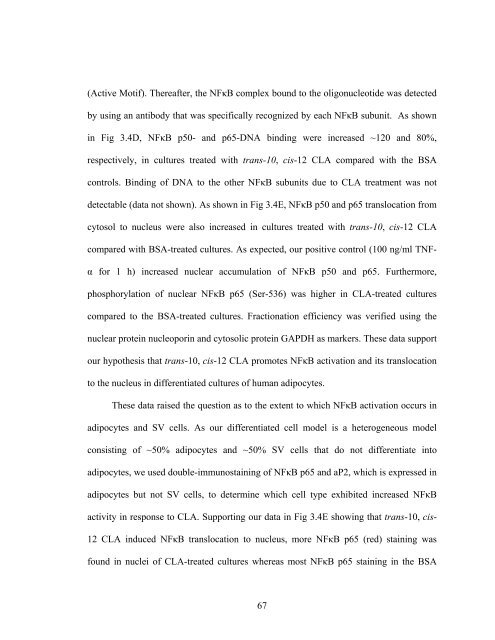CHUNG, SOONKYU, Ph. D. Mechanisms by Which Conjugated ...
CHUNG, SOONKYU, Ph. D. Mechanisms by Which Conjugated ...
CHUNG, SOONKYU, Ph. D. Mechanisms by Which Conjugated ...
Create successful ePaper yourself
Turn your PDF publications into a flip-book with our unique Google optimized e-Paper software.
(Active Motif). Thereafter, the NFκB complex bound to the oligonucleotide was detected<br />
<strong>by</strong> using an antibody that was specifically recognized <strong>by</strong> each NFκB subunit. As shown<br />
in Fig 3.4D, NFκB p50- and p65-DNA binding were increased ~120 and 80%,<br />
respectively, in cultures treated with trans-10, cis-12 CLA compared with the BSA<br />
controls. Binding of DNA to the other NFκB subunits due to CLA treatment was not<br />
detectable (data not shown). As shown in Fig 3.4E, NFκB p50 and p65 translocation from<br />
cytosol to nucleus were also increased in cultures treated with trans-10, cis-12 CLA<br />
compared with BSA-treated cultures. As expected, our positive control (100 ng/ml TNF-<br />
α for 1 h) increased nuclear accumulation of NFκB p50 and p65. Furthermore,<br />
phosphorylation of nuclear NFκB p65 (Ser-536) was higher in CLA-treated cultures<br />
compared to the BSA-treated cultures. Fractionation efficiency was verified using the<br />
nuclear protein nucleoporin and cytosolic protein GAPDH as markers. These data support<br />
our hypothesis that trans-10, cis-12 CLA promotes NFκB activation and its translocation<br />
to the nucleus in differentiated cultures of human adipocytes.<br />
These data raised the question as to the extent to which NFκB activation occurs in<br />
adipocytes and SV cells. As our differentiated cell model is a heterogeneous model<br />
consisting of ~50% adipocytes and ~50% SV cells that do not differentiate into<br />
adipocytes, we used double-immunostaining of NFκB p65 and aP2, which is expressed in<br />
adipocytes but not SV cells, to determine which cell type exhibited increased NFκB<br />
activity in response to CLA. Supporting our data in Fig 3.4E showing that trans-10, cis-<br />
12 CLA induced NFκB translocation to nucleus, more NFκB p65 (red) staining was<br />
found in nuclei of CLA-treated cultures whereas most NFκB p65 staining in the BSA<br />
67

















